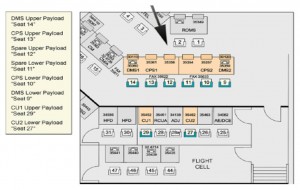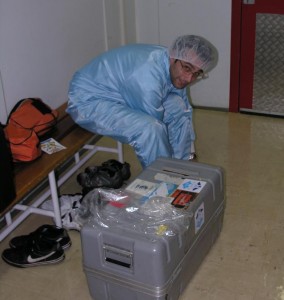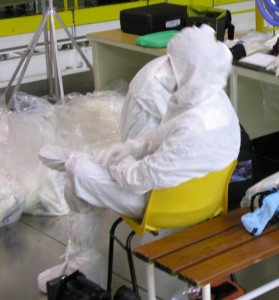 The next instalment of the launch diary from ESA’s Charlotte Beskow working on launch preparations in Kourou.
The next instalment of the launch diary from ESA’s Charlotte Beskow working on launch preparations in Kourou.
D – 13 : We have starting loading late cargo
Kourou Jan 28, 2011. Thursday
The Mission Manager [ESA’s Nico Dettmann] and myself (deputy mission manager) have done our voice-loop training in Jupiter II [one of the two Ariane 5 launch control rooms]. Nothing pleases an engineer more than new tools! Each control room is different and if you make the wrong configuration what you think is a private conversation ends up on the loudspeaker so it is worth paying attention.
The control room is arranged in a semi-circle with glass partitions separating the various entities.
Essentially it is arranged in two parts: the workers occupy the front, and the invited guests the rear. There is a glass wall separating these two halves. There are no doors. Inside the ‘workers area’ there are more separations; the front row is occupied by CSG staff responsible for each of the ground systems (telecom, telemetry, optics, etc.) while the second row has their managers, followed by the seats for the Arianespace link to the client, the Chef de Mission and then the client, i.e. us. We have six seats in the second row: the ESA Mission Manager, his deputy (myself), two representatives from Astrium, plus one each from NASA and RSC Energia (RSCE).
Behind us, separated by a glass partition (and a door that is operated only with a badge), sit our department head, ESA’s Director of Human Space Flight, the Arianespace Program Director (who is the contractual interface between the ATV project and Arianespace) and senior management representatives for Astrium, NASA and RSCE. The launcher authority (ESA and Arianespace), the CSG authority, the Head of ESA’s local Kourou Office and other managers occupy the other places.
Our places are indicated by the arrow in the image.
The launcher is managed from a different site – a bunker closer to the pad – and the launcher manager reports to the Range Director (DDO) via voice link.
What is interesting for me is that 15 years ago I worked in this very room and my position was the second from the left in the first row. So all this feels very familiar and yet not, since things have changed in 15 years.
In the afternoon everything was arranged to start loading the cargo. After a few mechanical glitches the team got started. In order to preserve the clean conditions inside ATV everyone on the platform had to wear what we call ‘bunny suit’ – getting in and out of a bunny suit takes time…
First the blue one when you enter the BAF
… then the white one closer to ATV
A bit of mechanical work to open the hatch… and then the team gets started.
What you see in the picture is the elevator we use to bring one person down into the ATV. Then one by one, each of the 28 [cargo] bags are lowered by winch (manually operated) and the operator in ATV-2 stows them into the correct, predefined location. When a shelf is full, the belt is tightened so that the cargo does not shift during launch/flight.
In two hours, 9 bags were loaded.
At 21:00, they packed up for the day, went home and got ready for Day 2, Saturday, 29 January. By the end of the day, all cargo should have been loaded and the hatch closed, not to be opened again on Earth.





 Automated Transfer Vehicle page
Automated Transfer Vehicle page ATV blog archive
ATV blog archive
 NASA Orion page
NASA Orion page NASA Artemis
NASA Artemis Airbus Orion page
Airbus Orion page
Discussion: 6 comments
ESA Bulletin, November 2010, page 10 states that the ATV-2 will carry two mini satellites from the US DoD. More information about it would be greatly appreciated. Thanks.
Hi Algol: Will check and reply.
AlgoL: See page 14 of the ATV-2 Info Kit. This describes the DoD payload.
A last transmission from the future space ‘black box’ Johannes Kepler will perform a last task before its disintegration in the atmosphere. A small device will share ATV’s trip: the Reentry Breakup Recorder (REBR) will gather data to help engineers understand reentry breakup and make reentering space junk less hazardous. It might also be a prototype for a black box system for future space transportation systems. As ATV-2 enters the atmosphere, the system will turn on its suite of sensors to record data on the vehicle’s breakup for about five minutes. Built by The Aerospace Corporation and funded by the US Air Force, this device contains miniature sensors that will collect information about temperature, pressure and other data to help define how ATV-2 responds as it reenters. The sensors and data recorder are enclosed in a heatshield that provides protection from the severe reentry environment.
The ATV-2 breakup due to aerodynamic heating and forces will cause REBR – a ‘cell phone with a heatshield’ – to be jettisoned from Johannes Kepler. This will cause REBR to activate its own transmitter and uplink the recorded data to an Iridium satellite. With this last ‘phone home’ before impact in the Pacific Ocean, the future space black box could be born.
Alogol: We’ve just found out quite a bit more on the REBR payload – we’ll also query the ATV cargo engineer on this and get back with more details. In the meantime, details from the manufacturer are here: https://blogs.esa.int/atv/files/2011/02/RB0273_REBR-Fact-Sheet_r5.pdf
Gentleman, I’ve also been trying to follow the REBR quite closely. I’m working on a thesis related to this material, and would be very curious to find out a little more about the system. More specifically, the particular sensors that were onboard. The link left by Daniel was the most up to date information I’ve found in a while (since some earlier papers on the system). Anyhow, if you happen to come across any additional information, I’d love to see it. Cheers.
Hi Mike: We haven’t forgotten about your query. It’s actually going to be tough for us to answer as no one at ESA is directly involved in this payload – it’s a NASA payload. You may get faster and more3 detailed information by contacting the REBR manufacturer in California directly. Cheers, — Daniel